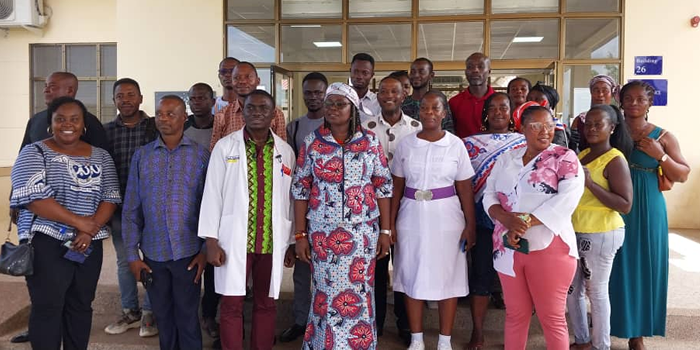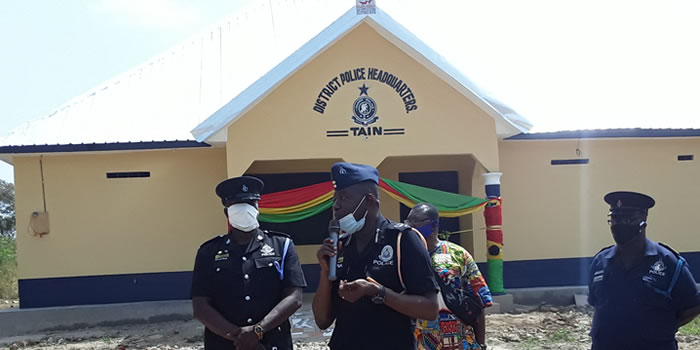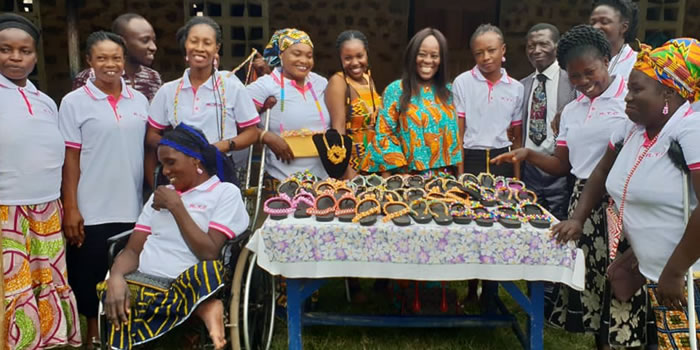

Physical and Natural Environment
Location and Size
Tain District was created in June 2004 by LI 2090, in the Brong Ahafo Region. It lies within latitudes 7 ½ and 8o 45` North and longitudes 2o 52`West and 0o 28` East. In terms of land area, Tain District covers 2,700sqkilometers.
The District shares common boundaries with Wenchi District to the East, Jaman North to the West, Sunyani West to the South and Berekum Municipal to the South West. It is also bounded by the Banda District to the North, La Cote d’Ivoire to the North West. Nsawkaw, the District capital is 18 miles from Wenchi, the capital of Wenchi Municipal Assembly which Tain was carved out.
The location of the big towns like Debibi, Brodi, Seikwa and Badu are far away from the district capital, Nsawkaw, and nearer to Districts like Berekum, Sampa and Sunyani deprive the district of the needed revenue as the big towns in Tain District transact business with these nearby Districts. This implies that there is the possibility of large amount of waste being generated in these big towns. Also, the fact that traders from other districts come in and trade means that in assessing the current and projected water and sanitation needs of the people, those who come from outside the district should also be catered for.
Since the District is an agrarian economy, it could take advantage of the vast arable land available for the cultivation of food and cash crops. This means that any future plans of undertaken plantation agriculture would not pose much problem with regards to land availability.
Geology and Soils
Geologically, the district is underlain mostly by the Birrimian formation. The area falls under lower Birrimian which consists of such metamorphosed sediments as phyillite and schist. There are also granite and grano-diorite in the south east and western parts of the district.
The greatest proportion of the district falls under savanna ochrosol with some lithoso. The land is generally low lying and most of the soils are sandy loam and in the valleys loamy soils exist.
The soils are fairly rich in nutrients and are suitable for the cultivation of crops such as maize, yams and cassava.
There are clay deposits for bricks and the soil supports the cultivation of transitional and forest crops like cashew.
The geological and soil formation of the district pose no difficulty as far as drilling for water in the district is concerned. The Birrimian formation makes it conducive for the drilling of water and coupled with the high water table in the district, the success rate in terms of water drilling is almost hundred percent (100%). Also, the soil type is very favourable for the cultivation of yam, cashew and other food crops.
Relief
The topography is predominantly undulating with gentle slopes of less than 1% inclination. The land generally rises from 30m above sea level to over 61m in the South West, with high elevations of 592.2m occurring around Kwametenten.
The fairly flat nature of the land and the fact that some land are serving as basins for tributaries shows that in future the construction of small towns water systems in these areas will not be a problem.
Biodiversity, Climate Change, Green Economy and Environment in General
The achievement of the Sustainable Development Goals (SDGs) by 2030 and Africa’s Agenda 2063 has been a topmost priority of the government; however, poverty just would not allow that to happen. Poverty is one of the development conundrums dragging down the progress of the country; it is a stumbling block towards the government achieving a good standard of living for the people.
The existence of climate change has made way for the decline of economic activities in the District; the stronghold of the local economy has adversely been affected through the incidents of climate change. Agriculture, which is the greatest contributor of the District’s revenue, and the main survival of the people in the district, has been affected greatly by climate change. Climate change has led to low production of agriculture produce, and destruction of many social amenities. The effect is not only on the environment and the local economy of the country, but also in the daily activities of women as well.
According to the Wikipedia, climate change is a change in the statistical properties of the climate system, when considered over periods of decades or longer, regardless of cause. Accordingly, fluctuations on periods shorter than a few decades, such as do not represent climate change.
In Tain, climate change has been as a result of activities like water pollution, bush fire and deforestation. Deforestation and bush fire are activities which the Tain District has been experiencing.
Human activities such as deforestation and bush fire can be considered factors which have led to extreme effects of climate change in the district. In Ghana, as most of the population can be found in the rural areas, deforestation in this sense cannot be attributed to the government only, but the people who, day in and day out, cut down smaller trees in the forest for firewood and charcoal burning, for domestic purposes in the rural areas, and is considered as saving cost and time.
Moreover, people involved in the illegal cutting down of trees for furniture and export purposes cannot be left out in the issue of deforestation, as their activities have the most effect on climate change.
The UNCED research indicates that the most recent survey on deforestation and greenhouse gas emissions reports that deforestation may account for as much as 10% of current greenhouse gas emissions. Greenhouse gases are gases in the atmosphere that literally trap heat. There is a theory that as more greenhouse gasses are released into the atmosphere, more heat gets trapped. Thus, there is a global warming trend, in which the average temperature becomes progressively higher.
Agriculture in Tain can be termed one of the main activities that the people take pride in, as reports indicate that it employs about 80% of the district's labour force and one major source of income for the people. Food production in the district solely depends on the climate, that is to say, crop cultivation depends on the existing rain and weather pattern. Almost all the population relies on the product, both for domestic and commercial purposes.
Many people in business have given a confirmation that owing to the present economic hardship, the involvement of any form of business does not go well, unless one is engaged in the sale of agriculture products. According to them, since access and availability of food is one of the main concerns of most of the population, engaging in agriculture is a good source of income. According to the UN Food and Agriculture Organisation (FAO), climate change will directly affect future food availability, and compound the difficulties of feeding the world's rapidly growing population.
Additionally, the effect of climate change has been very visible in the lives of women in the district. The effect of the sun has led to the disappearance of many water bodies, leading to the people experiencing water shortage coupled with the lack of potable water.
Women, who are in charge of the household, have no choice than to walk for miles before getting one bucket of water to take care of the home. For some, due to the walking distance, they prefer to bring to the water-side their dirty clothes and that of their families to wash them there, instead of walking for several miles for just a bucket of water, which will not be even sufficient for washing. According to these women, most of the water-bodies they rely on for their domestic chores have turned into dry lands, they have no choice than to spend most of the hours of the day in search of water.
As if that is not enough, the effect of climate change in 2007, 2010 and 2016 during the rainy season, led to loss of properties, as well as farms, and inaccessibility to some parts of the district, since the rain fell more than expected, causing flooding in the district.
Climate change, due to its adverse effects on the environment, has now become a developmental issue, and has harsh implications on the progress of the district. It is a scourge that the problems and causes of climate change in the country have been identified, but the fight against it has been a very minimal, as apart from natural causes, everyone is a culprit in negative human activities.
Farmers should therefore learn to have good storage systems for water, so as to still keep the plants and household going when there is a long dry season.
Furthermore, it is important to stop the cutting down of trees. Climate change is indeed deepening the poverty level of Ghana, making all citizens at risk of low standards of living, and it is in this case the obligation of every citizen to wage war against the rapid effect of the changing climate.
Natural and man-made disasters
In recent years these hazards took toll of thousands of lives and caused massive destruction of property. These have adversely affected the vital sectors of our development as agriculture, communication, irrigation, power projects and rural and urban settlements. The time and cost overrun in some cases have been enormous but their indirect impact on our economy has never been calculated.
Disasters, natural or man-made can strike at any time. It is nature’s way of altering terrains and creating new bio diversities. Flood hazard become a vicious threat rather than a natural occurrence when humans interfere with flood plains. The impact of flood disaster is felt most by the poorest members of society particularly those whose livelihoods are tied to the climate sensitive sectors of the economy such as rain fed agriculture. Floods are often blamed on natural hazards however human activities on the environment exacerbate the effects of natural hazards often causing widespread damages to lives and property.
Among the numerous constraints faced by the people within the district is the issue of bushfire. Bushfire has been identified to be one of the major socio-economic problems besetting the development of the district. The vegetation cover is consumed every year by wild fire.
It is not common to find even an acre of land with vegetation cover all year around. This menace has not only affected density and diversity of the vegetation in the ecosystem but has also lowered the productivity of the land and the general agricultural output. Protecting the integrity of the sensitive environment will be of immense importance since most of the people obtain their livelihoods from the environment. Eradicating bushfire will only be successful if the root causes are identified and broad based strategies designed to fight it.
Natural resource utilization
The District is blessed with natural resources ranging from rivers, minerals, forest products and fertile land for the production of cashew.
Some of the tourist sites identified in the district include Archaeological site at Hani, Menji Crocodile Pond, confluence of rivers Nyimepene and Tain at Tainso and Degedege Irrigation Dam. None of these tourist sites has been developed yet and this when developed, can generate a lot of revenue for the District.
Nature has blessed the district with gold and sand deposits in abundance. Potential investors who are into sand winning and gold mining could also explore these areas in the district. There is the existence of Birrim Goldfields Company in the district and they are into exploration of more gold sites.
The original forest vegetation has been subjected to degradation, caused mainly by the indiscriminate bush fires, slash and burn agriculture, logging and felling of trees for fuel over the years.
The cumulative effect is that secondary vegetation occurs in cultivated areas. Timber species like Odum, Sapele, Wawa and Mahogany are found in places around the northern part of the District. In the semi-derived savanna areas, there are the absence of large economic trees as a result of logging, charcoal burning and mechanized farming.
The grooves show that with protection, forest in the area can be productive because the soils in the sacred groves appear more fertile compared to soils lying a few metres away which have been laid bare by intensive cultivation and other unsustainable uses. In the grooves, wildlife like deer and antelope are found there. Other forest reserves are Sawsaw, Yaya and Bawa watershed are found in the district. The combination of the vegetation zones – guinea savannah, transitional zone and the forest permit the cultivation of a variety of crops – cereal, tubers and vegetables and even animal rearing.
The forest reserves and the few groves around the water bodies in the district help to protect these water bodies like the Nyimpene and the Tain. This means these rivers could be good sources of water when constructing small town water systems in future and could serve as irrigation facilities for those around. In addition, the existence of wildlife like deer and antelopes in the groove can serve as tourism potential for the District.
Date Created : 11/20/2017 5:47:46 AM












 facebook
facebook
 twitter
twitter
 Youtube
Youtube
 +233 593 831 280
+233 593 831 280 0800 430 430
0800 430 430 GPS: GE-231-4383
GPS: GE-231-4383 info@ghanadistricts.com
info@ghanadistricts.com Box GP1044, Accra, Ghana
Box GP1044, Accra, Ghana